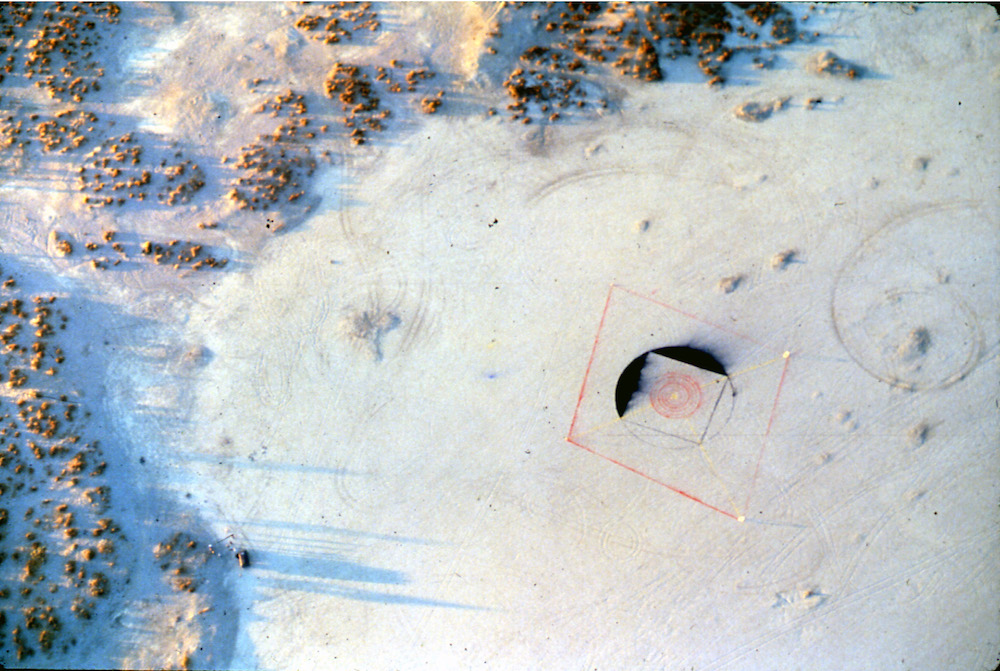A matriarch of the Land Art movement that is closely associated with the American Southwest, Lita Albuquerque has engaged with the surface of Earth from the South Pole to Saudi Arabia, Peru to Paris. But she has always given special attention to the music of the stars, and to the desert—a fixture of both her Tunisian heritage and her life in LA. Albuquerque’s iconic celestial blue-and-gold sculptural paintings are often likened to interdimensional portals, but her multivalent work extends to architectural installation, dance-based performance, film and investigations in the natural and observational sciences.
“Oh, I can talk about science!” Albuquerque exclaims over a Zoom call. “It started in 1969, when our car broke down in the Sahara. We saw a house in the distance and as we walked towards it, we realized it belonged to friends. When we arrived, they were watching the Moon landing live on TV! It could not have been more extraordinary; it rocked my world. Seeing Earth from space was a revolution in perspective as big as the Renaissance.”
Six years later, alone in the sarcophagus hall of The Met, she heard a disembodied voice say, “Pay attention to the feet.” Only later in the studio did she realize the message she was meant to receive: “Pay attention to the Earth.” She did. Albuquerque’s seminal 1978 piece Malibu Line—the first of what would become a signature process of laying organic pigments in geometrical patterns, activating energies of the landscape to connect body, earth and sky—was a cliffside trench of blue pigment that seemed to extend from her feet on the ground out to the horizon of sea and sky.
-

-

"Malibu Line," 2024. Photo by Marc Breslin. Courtesy of the artist and Los Angeles Nomadic Division.
-

In June of this year, Albuquerque reimagined this piece. The new version was set further back into Malibu’s steep, winding canyons, giving the feeling of being at the source of a mountain stream carving its path down the hillside toward the sea. Though partly inspired by PST’s 2024 theme of art and science, Albuquerque’s recreation, presented by Los Angeles Nomadic Division, largely flowed from her communion with curator Ikram Lakhdhar, who is Tunisian herself. “We got to talking, and of course I grew up in Carthage, a site of history of the earth, the sea, the middle of the sky, the cosmos,” she says. “That side of me is so much a part of my work. I think the new Malibu Line came to be because Ikram saw that the line was really a longing for home.”
The stars have long figured in Albuquerque’s work. “Some of my most grounding research is in 9th- to 12th-century Islamic science and astronomy,” she says. “When I did Stellar Axis in 2006 at the South Pole, I chose 99 of the brightest stars in the Southern hemisphere and made a symphony from their names. Just about all of them are in Arabic—named by the people who discovered them.” For Albuquerque, in contrast to traditional Western thought, the scientific has always been in concert with the spiritual. “The sacred aspect,” she explains, “I think that’s what we’ve forgotten.”
With PST, Albuquerque has two further opportunities to explore these ideas closer to home. Researching California’s intertwined excavations of space and gold, she learned that in 1952, two Caltech astrophysicists won the Nobel Prize for their work on nucleosynthesis, positing that heavier elements like gold form by exploding supernovae. At Caltech’s Pasadena campus, she’ll be gold-leafing a bridge in their honor. A Moment in Time opens in September, and in honor of its culmination on December 15, there’ll be a performance with dancers and singers, and a musical score inspired by the heady theory. She’ll also open a solo show in September, at Kohn Gallery, in which she will place a vast, thin layer of granite that looks as if the floor was removed to reveal the earth. As people carefully walk around its edges, she notes, they’ll really need to “pay attention to their feet.”





